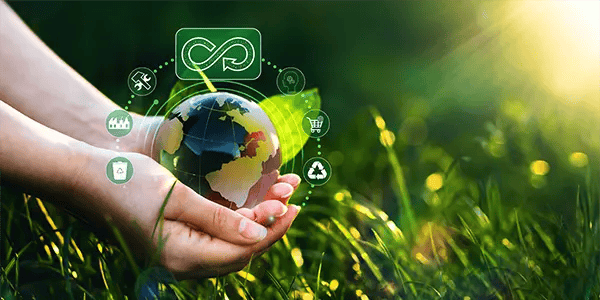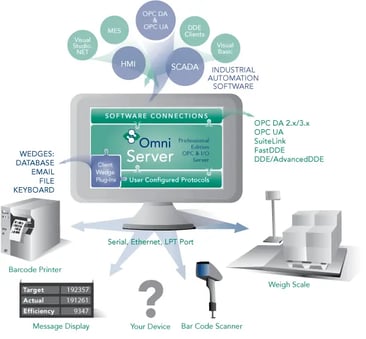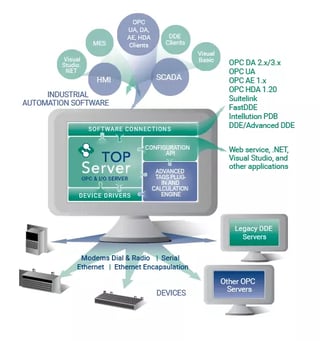In this first installment of our 2024 Environmental Sustainability Blog Series, we’re going to piggyback on last year’s Waste Reduction blog post, and take things a step farther – how can you incorporate aspects of a circular economy to positively impact your work environment? In this blog post we’ll discuss what a circular economy is, the impact circular economies have on the environment, and how software that leverages OPC Standards and the automation industry can play a pivotal role in fostering its success.
Most of us should be familiar with the three R’s – reduce, reuse, recycle – and are familiar with how these actions involve production and consumption of resources, but are you familiar with a circular economy?

At its core, a circular economy is about creating a closed-loop system where resources are reused, recycled, or regenerated at the end of their lifecycle. It's a departure from the traditional linear economy, which provides a limited emphasis on recycling or reusing materials. Product longevity and the ability to disassemble-reassemble a product are paramount in a circular economy. In many images depicting a linear economy, you can see that recycling is included; however, "the entire linear supply chain must be rearranged to become circular." In a circular economy, the goal is to design and create products that last longer, materials are recovered and repurposed, and waste is minimized.
Far from the linear "take-make-dispose" model, a circular economy aims to redefine our approach to production and consumption, emphasizing sustainability, resource efficiency, and waste reduction.
So how do we move from a linear economy to a circular economy? By changing the flow of materials to a circular pattern!
- Reintegrating waste into new products.
- Recovering and retaining energy from one step to the next.
- Adding further energy from renewable sources as needed.
- Designing and manufacturing products to apply these concepts.
Environmental Impact of a Circular Economy
The environmental benefits of a circular economy are profound. By keeping resources in use for as long as possible, it reduces the need for continued raw material extraction, thereby conserving natural resources and minimizing habitat destruction. Moreover, it curtails the generation of waste and pollution, mitigating the strain on landfills and ecosystems. From reducing greenhouse gas emissions to preserving biodiversity, the circular economy offers a holistic approach to environmental stewardship.
You Might be Wondering: How Can I Begin to Make the Transition from a Linear Economy to a Circular Economy?
Government and industry play large roles in educating and making consumers aware of buying options, but consumers can also stimulate behavior by researching and finding circular options! For example, you may have chosen to purchase a reusable grocery bag at the grocery store checkout recently (brownie points if it was made from recycled plastic!). You have made an informed decision (I purchased a reusable bag, so that I don’t need to continue using single use plastic bags) combined with a goal towards advancing sustainability (I’m buying a multi-purpose product, made from recycled material, and by doing this, I’m not adding more plastic to a landfill in the long run). This is all it takes to move from a linear-framed economic ideology to a circular one. It doesn’t matter what the scale of the decision is – it all adds up!


In our world of automation, software that leverages open OPC standards, such as the TOP Server and OmniServer, have emerged as powerful enablers of the circular economy. Here's how they contribute:
- Efficient Resource Management: The TOP Server and OmniServer facilitate seamless communication and integration between various components of industrial automation systems using open standards, ensuring any system that needs information has it. This interoperability enables real-time monitoring of resource utilization, optimizing processes for maximum efficiency. By empowering systems that minimize resource wastage and improving resource allocation, TOP Server and OmniServer drivers are helping industries transition towards a more sustainable operational model. Read more about a real-world example here.
- Predictive Maintenance: Automation systems that leverage open OPC standards to access real-time and historical data can utilize data analytics and machine learning algorithms to predict equipment failures and schedule maintenance proactively. By preventing unexpected breakdowns and prolonging the lifespan of machinery, predictive maintenance minimizes the need for premature replacements, thus reducing waste and conserving resources.
- Optimized Production Processes: Automation inherently plays a crucial role in streamlining production processes to minimize material waste and energy consumption. For example, OmniServer enables connecting to non-standard non-PLC devices and pass that information to process and business systems via OPC DA, OPC UA, or SuiteLink, facilitating data exchange between different automation systems and enabling synchronized operations and adaptive control strategies. Our TOP Server drivers can provide data in real-time allowing that resources are utilized efficiently, contributing to a more sustainable manufacturing ecosystem.
- Closed-Loop Supply Chains: Software that leverages open OPC data exchange standards facilitates the seamless integration of supply chain processes, enabling end-to-end visibility and traceability of materials and products. This transparency is essential for establishing closed-loop supply chains, where materials are recovered, refurbished, or recycled to create new products. By enabling circular supply chain management, OPC software promotes resource conservation and waste reduction across the entire product lifecycle.
The transition towards a circular economy is imperative for addressing the environmental challenges of our time. By reimagining our approach to production and consumption, we can create a more sustainable and resilient future for generations to come. Open standards-based software, such as TOP Server and OmniServer, offer powerful tools for realizing this vision, empowering industries to embrace the principles of the circular economy and drive positive environmental impact.
As we harness the potential of these technologies, let us strive towards a world where prosperity is synonymous with sustainability, and where the circular economy paves the way towards a brighter tomorrow.
Where Can I Get More Information on OmniServer and TOP Server?
Please feel free to contact our support team with any questions and remember to subscribe to our blog for more quick and easy OmniServer and TOP Server tutorials and tips. And, if you haven't already, make sure to download the latest free trial version of OmniServer and TOP Server to get started connecting your own devices.




